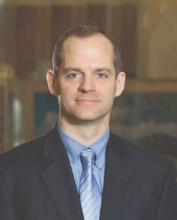As the obesity epidemic continues to rage unabated and diabetes takes its toll on nerves, I am seeing an increase in diabetic foot ulcers.
Traditionally, we have used topical therapies and dressings and pressure relief through accommodative footwear. This usually produces moderate to no effect in many of my patients. Perhaps this is because we are not monitoring in the clinic every other day, or patients are having a difficult time adhering to the complex wound care regimens we prescribe.
Then along came MIST, a proprietary, noncontact ultrasound device delivering low-frequency/low-intensity ultrasound waves via atomized sterile saline. Researchers at our institution have published data suggesting the efficacy of this treatment.
You’ll notice these data are far from new. Sorry to be late to the party, but what is new is my own case series of patients who have done astoundingly well with this therapy.
MIST Therapy heals by activating fibroblasts, reducing bacterial count, and disrupting that pernicious biofilm. The recommended regimen is three treatments per week, with treatments lasting 3-20 minutes depending on wound size. Larger wounds get longer treatments. Many centers are using this therapy exclusively when more than minimal debridement is required.
The MIST Therapy website suggests that this therapy is associated with a $2,600 cost savings over standard of care (estimated to be $10,300). In March 2013, the American Medical Association approved a CPT I code (97610) for MIST Therapy, which became effective in 2014.
Perhaps this code has resulted in more widespread use. However, my wound care colleagues said they have been using this for years prior to the code being issued, and reimbursement has not been a problem.
What I have noticed is how clean and healthy the wounds look very early in the treatment cycle. If you are not adding this therapy to your program for addressing foot ulcers, you need to. Ask your local wound care center about it, and apologize (for me) for being so late to the party.
Dr. Ebbert is professor of medicine, a general internist at the Mayo Clinic in Rochester, Minn., and a diplomate of the American Board of Addiction Medicine. The opinions expressed are those of the author and do not necessarily represent the views and opinions of the Mayo Clinic. The opinions expressed in this article should not be used to diagnose or treat any medical condition, nor should they be used as a substitute for medical advice from a qualified, board-certified practicing clinician. Dr. Ebbert has no relevant disclosures.


